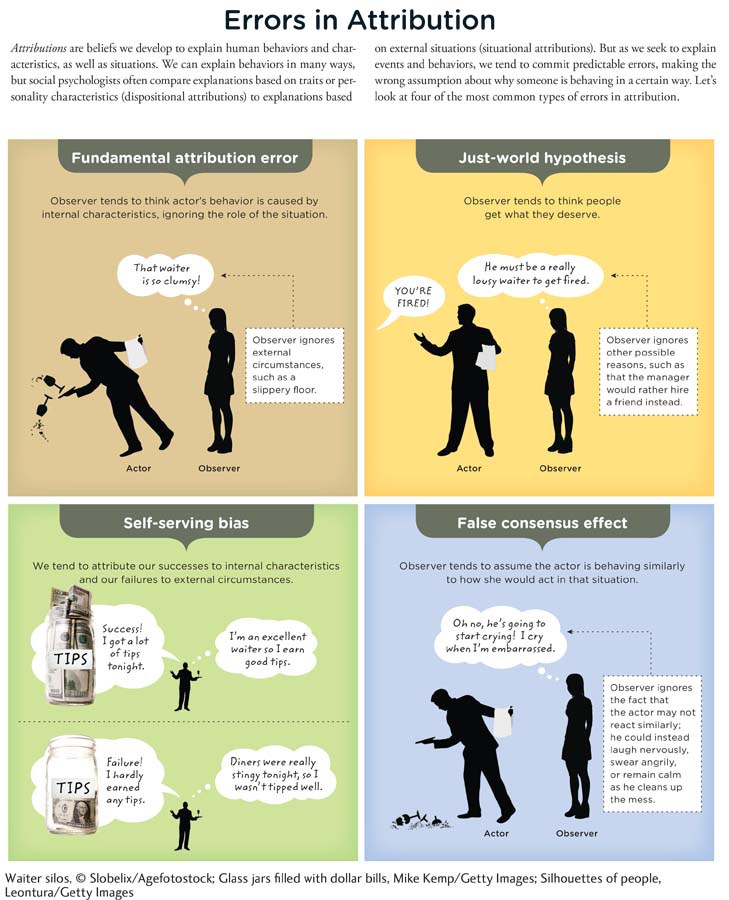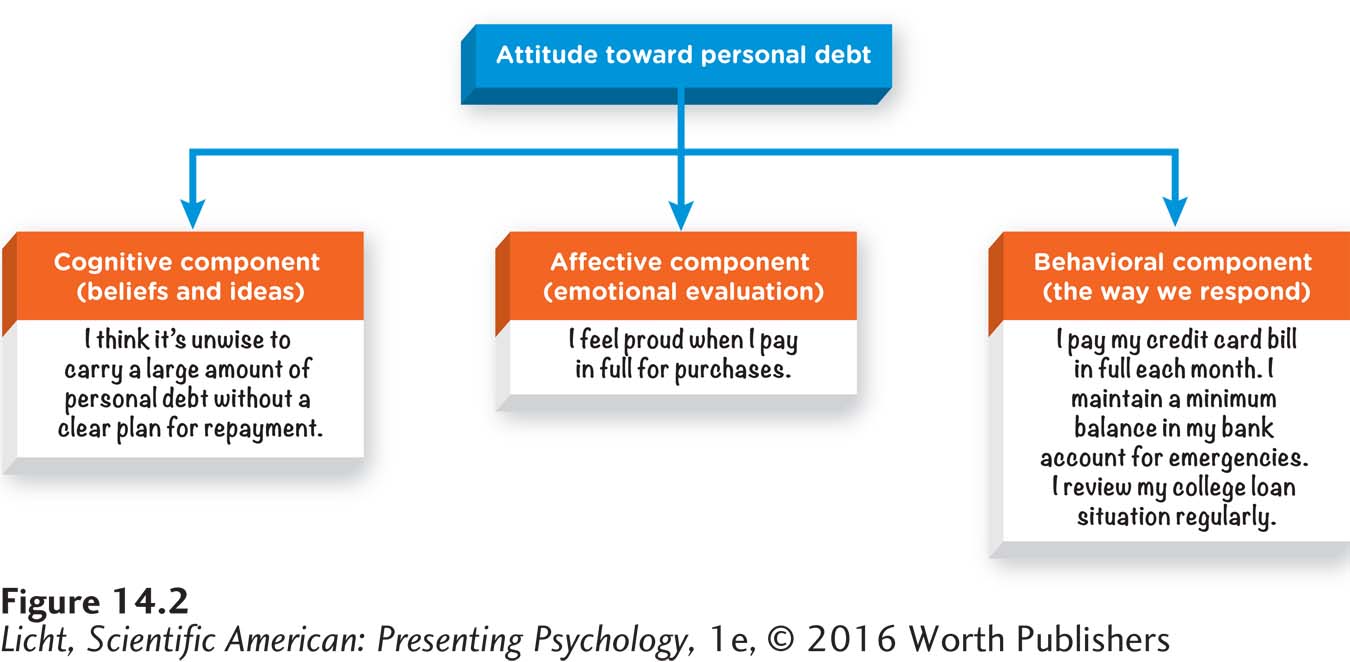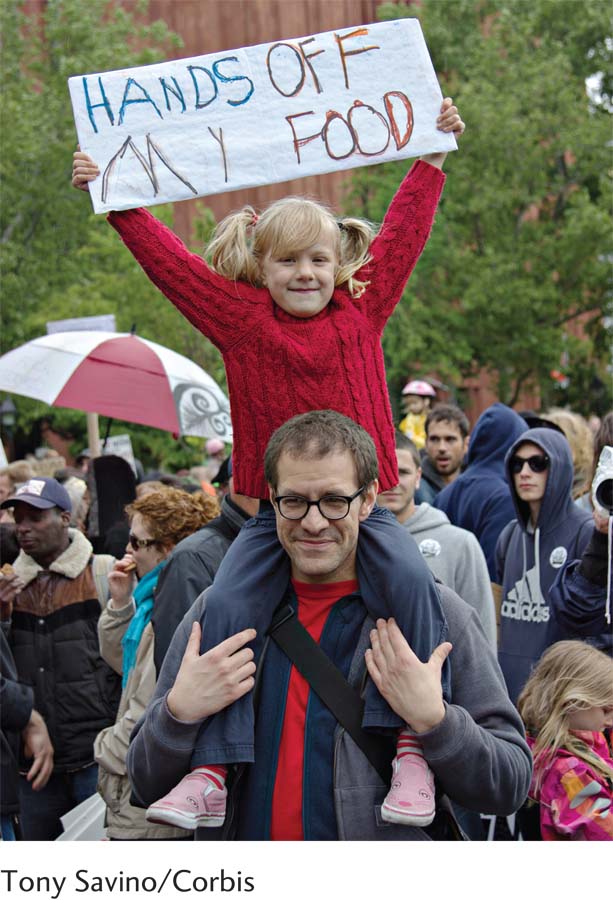14.2 Social Cognition
 THE DATING GAME Joe and Susanne’s story begins right around Valentine’s Day 2006, when Joe decided to sign up for a full membership to Match.com. A couple of days after Joe joined the site, Susanne came across his page. “I thought he was cute,” she says. “That was obviously the reason why I originally opened it.” Joe was a burly guy with a dynamite smile, and Susanne was drawn to big, teddy bear types. Reading his profile, she was immediately intrigued. “The fact that he was a single parent, you know, kind of piqued my interest,” she says. Before long, Joe was checking out Susanne’s page, liking what he saw, and he initiated the e-
THE DATING GAME Joe and Susanne’s story begins right around Valentine’s Day 2006, when Joe decided to sign up for a full membership to Match.com. A couple of days after Joe joined the site, Susanne came across his page. “I thought he was cute,” she says. “That was obviously the reason why I originally opened it.” Joe was a burly guy with a dynamite smile, and Susanne was drawn to big, teddy bear types. Reading his profile, she was immediately intrigued. “The fact that he was a single parent, you know, kind of piqued my interest,” she says. Before long, Joe was checking out Susanne’s page, liking what he saw, and he initiated the e-
Attributions
LO 2 Describe social cognition and how we use attributions to explain behavior.
CONNECTIONS
In Chapter 13, we described psychoanalysis, one goal of which is to increase awareness of unconscious conflicts. Here, we discuss how unconscious processes can drive social behaviors. Therapists can help clients become aware of these unconscious influences.
Put yourself in Joe or Susanne’s position. There you are on Match.com, looking at the profile page of someone you find attractive. On a conscious level, you are tallying up all the interests you have in common and scrutinizing every self-
social cognition The way people think about others, attend to social information, and use this information in their lives, both consciously and unconsciously.
Whatever your decision may be, it is very much reliant on social cognition—the way you think about others, attend to social information, and use this information in your life, both consciously and unconsciously. Joe and Susanne used social cognition in forming first impressions of one another. You use social cognition anytime you try to interpret or respond to another person’s behavior. Let’s take a closer look at two critical facets of social cognition: attributions and attitudes.
In Chapter 7, we defined cognition as the mental activity associated with obtaining, storing, converting, and using knowledge. Thinking is a specific type of cognition that involves coming to a decision, forming a belief, or developing an attitude. In this section, we examine how cognition and thinking affect the way we use social information.
WHAT ARE ATTRIBUTIONS? Joe and Susanne’s relationship has always been fairly open, with Joe rarely having to wonder what Susanne is thinking and vice versa. This is usually not the case with online dating, or any kind of dating for that matter. The “dating game” typically involves a lot of guesswork about the other person’s behavior: Why didn’t he call back? What did she mean by that  yesterday? These kinds of questions have relevance for all human relationships, not just the romantic kind. Just think about how much time you spend wondering why people do the things that they do. The “answers” you come up with to resolve these questions are called attributions.
yesterday? These kinds of questions have relevance for all human relationships, not just the romantic kind. Just think about how much time you spend wondering why people do the things that they do. The “answers” you come up with to resolve these questions are called attributions.

attributions Beliefs one develops to explain human behaviors and characteristics, as well as situations.
Attributions are beliefs we develop to explain human behaviors and characteristics, as well as situations. “Why is my friend in such a bad mood?” you ask yourself. Your attribution might be, “Maybe he just got some bad news” or “Perhaps he is hungry.” When psychologists characterize attributions, they use the term observer to identify the person making the attribution, and actor to identify the person exhibiting a behavior of interest. If Joe was trying to explain why Susanne had checked out his profile page, then Joe is the observer and Susanne is the actor.
ATTRIBUTIONAL DIMENSIONS There are many types of attributions, and differentiating among them is quite a task. To make things more manageable, psychologists often describe attributions along three dimensions: controllable–
Controllable–
Stable–unstable dimension: Why did Joe cook Susanne a delicious dinner of pork chops? Susanne could infer his behavior stemmed from a longtime interest in cooking. This would be an example of a stable attribution. With stable attributions, the cause is long-
situational attribution A belief that some environmental factor is involved in the cause of an event or activity.
Internal–
dispositional attribution A belief that some characteristic of an individual is involved in the cause of a situation, event, or activity.
Dispositional attributions are a particular type of internal attribution in which the presumed causes are traits or personality characteristics. Here, we refer to a subset of internal attributions that are deep-
LO 3 Describe how attributions lead to mistakes in our explanations for behaviors.
When people make attributions, they are often guessing about the causes of events or behaviors, which of course leaves plenty of room for error. This is particularly true with situational and dispositional attributions. Let’s take a look at four of the most common mistakes (Infographic 14.1, below).
INFOGRAPHIC 14.1

fundamental attribution error The tendency to overestimate the degree to which the characteristics of an individual are the cause of an event, and to underestimate the involvement of situational factors.
Synonyms
fundamental attribution error correspondence bias
FUNDAMENTAL ATTRIBUTION ERROR Suppose you are checking out some profiles on a dating Web site. You see someone cute and reach out with ;-) (a “wink”), but never hear back. If you fall prey to the fundamental attribution error, you might automatically assume the person’s failure to respond results from her shyness (a dispositional attribution), but another reason might be that her Internet is down (a situational attribution). This is a common tendency; we often think that the cause of other people’s behaviors is a characteristic of them (a dispositional attribution) as opposed to the environment (a situational attribution) (Ross, 1977; Ross, Amabile, & Steinmetz, 1977). We easily forget that situational factors can also have a powerful effect, and assume that behaviors are the consequence of a person’s disposition (Jones & Harris, 1967). When thinking about what causes or controls behavior, we “underestimate the impact of situational factors and . . . overestimate the role of dispositional factors” (Ross, 1977, p. 183).
CONNECTIONS
In Chapter 7, we described heuristics, which are used to solve problems and make decisions. But heuristics are not always reliable. Here, we see how the fundamental attribution error can lead to errors in clinical reasoning. Critical thinking takes effort and time, so it is not unusual to depend on cognitive shortcuts.
How do you think this happens? One suggestion is that we have a tendency to make quick decisions about others, often by labeling them as certain types of people. Imagine how dangerous this could be in a medical setting, when doctors and nurses need to make quick choices about treatment. A nurse seeing a patient who has slurred speech, can’t walk, and is aggressive might assume he is drunk and an “alcoholic,” ignoring other situational factors that might be involved, such as homelessness and severe dehydration (Levett-

Esther Grant holds a painting of Brian Sinclair, the man who died of a treatable urinary tract infection after waiting in a Winnipeg emergency room for 34 hours. Why was Sinclair ignored, even after various people in the emergency room approached hospital staff to voice their concern (Kubinec, 2013, September 5)? Perhaps it had something to do with the fact that Sinclair was a homeless, disabled ethnic minority (Fries, 2011, September 23). Using limited information to make assumptions about people can be very risky in a medical setting.
Yet we must make do with the information we have—
just-
JUST-
This belief in a just world, to some degree, may result from cultural teachings. Children in Western cultures are taught this concept so that they learn how to behave properly, show respect for authority figures, and delay gratification (Rubin & Peplau, 1975). For example, in the original tale of Cinderella (Grimm & Grimm, 1884), doves rest on Cinderella’s shoulders prior to her wedding to the Prince. As the bridal party enters and leaves the church, the doves poke out her evil stepsisters’ eyes—
CONNECTIONS
In Chapters 10 and 11, we introduced the concept of internal locus of control, which refers to the tendency to feel in control of one’s life. People with an internal locus tend to make choices that are better for their health. The self-
self-
SELF-
You might be surprised to learn that therapists can also fall prey to this bias (Murdock, Edwards, & Murdock, 2010). When clients end their psychotherapy earlier than therapists recommend, therapists tend to think the causes are due to the client’s situation (lack of finances) or something within the client (resistance to change), as opposed to some factor within themselves (the therapist). But when considering the same situation for another therapist, they tend to identify the opposite pattern, blaming the other therapist for the early termination of therapy.

There are many reasons the bathroom is messy, but none of them have to do with the little boy Calvin. Here we have an example of self-
false consensus effect The tendency to overestimate the degree to which others think or act like we do.
CONNECTIONS
In Chapter 7, we describe how the availability heuristic is used to predict the probability of something happening in the future based on how easily we can recall a similar event from the past. The false consensus effect is a special type of this heuristic; our judgments about the degree to which others think or act like we do seem to be based on this availability heuristic.
FALSE CONSENSUS EFFECT When trying to decipher the causes of other people’s behaviors, we overrely on knowledge about ourselves. This can lead to the false consensus effect, which is the tendency to overestimate the degree to which people think or act like we do (Ross, Greene, & House, 1977). And when others do not share our thoughts and behaviors, we tend to believe they are acting abnormally or inappropriately. This false consensus effect is evident in our beliefs about everything from celebrities—
Attribution errors may lead us astray, but we can minimize their impact by being aware of our tendency to fall back on them. Now it’s time to explore another facet of social cognition. Where did you get that attitude?
Attitudes
attitudes The relatively stable thoughts, feelings, and responses one has toward people, situations, ideas, and things.
For many people, including Joe and Susanne, the purpose of online dating is to find someone who shares common values, interests, and lifestyle choices—
Psychologists suggest that attitudes are composed of cognitive, affective, and behavioral components (Figure 14.2 on page 561). The cognitive aspect of an attitude refers to our beliefs or ideas about an object, person, or situation. Generally, our attitudes include an emotional evaluation, which is the affective component relating to mood or emotion. We often have positive or negative feelings about objects, people, or situations (Ajzen, 2001). Feelings and beliefs guide the behavioral aspect of the attitude, or the way we respond.
CONNECTIONS
In Chapter 5, we described classical conditioning and how it might instill emotions and attitudes toward product brands. Observational learning can lead children to imitate others, including their attitudes.

Attitudes are composed of cognitive, affective, and behavioral components. Cognitive and affective components usually guide the behavioral aspect of an attitude.
WHERE DO ATTITUDES COME FROM? Of all the nature–
CONNECTIONS
In Chapter 7, we explored the heritability of intelligence. Heritability is the degree to which hereditary factors are responsible for differences across a variety of physical and psychological characteristics. Heritability research often involves comparing identical and fraternal twins, as is the case here regarding attitudes.
That being said, genetic factors do play a role. But to what degree? One of the best ways to gauge the relative weights of nature and nurture is through the study of twins. If nature has a substantive effect on attitudes, then the following should be true: Identical twins (who have the same genetic makeup) should have more similar attitudes than fraternal twins (who share about 50% of their genes). Let’s take a look at some research to see if this is the case.
Nature and Nurture
Why the Attitude?
 How do you feel about rollercoasters? How about alcohol consumption? Where do you stand on the death penalty? These are just a few of the attitude topics researchers have explored in the context of nature and nurture. One study of several hundred pairs of twins concluded that most of the attitude variation among participants resulted from nonshared environmental factors, or distinct life experiences. But a significant proportion of attitude differences—
How do you feel about rollercoasters? How about alcohol consumption? Where do you stand on the death penalty? These are just a few of the attitude topics researchers have explored in the context of nature and nurture. One study of several hundred pairs of twins concluded that most of the attitude variation among participants resulted from nonshared environmental factors, or distinct life experiences. But a significant proportion of attitude differences—
DOES THIS MEAN . . . EACH OF US IS BORN WITH A “PRO-
Does this mean that each of us is born with a “pro-

Children and parents frequently have the same attitudes about politics and social issues. To a certain degree, these similarities trace to common personality traits, which are partly inherited (Kandler et al., 2012). But attitudes are more strongly influenced by life experiences (Olson et al., 2001).
More recent research, also involving twins, offers evidence that political attitudes are influenced by genes. As with the earlier twin study, the relationship between genes and attitudes appears to be indirect; personality traits, which are highly heritable, seem to predispose people to certain political attitudes. But as the researchers point out, family members and peers can also mold political inclinations (Kandler, Bleidorn, & Riemann, 2012). It makes good sense if you think about it: If someone important to you takes a certain political stance, it might seem more appealing, or at least tolerable. The bottom line: Nurture may come out ahead in this particular case, but nature holds its own. 
We have established that attitudes are shaped by experience and, to a lesser extent, heredity. But what impact do these attitudes have on everyday life?
CAN ATTITUDES PREDICT BEHAVIOR? There are many factors determining whether an attitude can predict a behavior (Ajzen, 2001). The strength of an attitude is important, with stronger, more enduring attitudes having a greater impact (Armitage & Christian, 2003; Holland, Verplanken, & Van Knippenberg, 2002). Specificity is also key; the more specific an attitude, the more likely it will sway behavior (Armitage & Christian, 2003).
Not surprisingly, people are more likely to act on their attitudes when something important is at stake—
We now know that attitudes can influence behaviors, but is the opposite true—
didn’t SEE that coming
Something Doesn’t Feel Right
cognitive dissonance A state of tension that results when behaviors are inconsistent with attitudes.
 Most people would agree that cheating on a girlfriend, boyfriend, or spouse is not right. Even so, some people contradict their beliefs by seeking sexual gratification outside their primary relationships. How do you think cheating makes a person feel—
Most people would agree that cheating on a girlfriend, boyfriend, or spouse is not right. Even so, some people contradict their beliefs by seeking sexual gratification outside their primary relationships. How do you think cheating makes a person feel—
APPARENTLY, THE BIG BUCKS MADE IT EASIER TO JUSTIFY THEIR LIES.
The phenomenon of cognitive dissonance was elegantly brought to light in a study by Leon Festinger and J. Merrill Carlsmith (1959). Imagine, for a moment, that you are a participant in this classic study. The researchers have assigned you to a very boring task—
Regardless of how you may feel about these activities, you have been paid money to convince someone else that they are a blast: “I had a lot of fun [doing] this task,” you say. “It was intriguing, it was exciting . . .” (Festinger & Carlsmith, 1959, p. 205). Unless you like performing repetitive behaviors like a robot, we assume you would feel some degree of cognitive dissonance, or tension resulting from this mismatch between your attitude (Ugh, this activity is so boring) and your behavior (saying, “I had so much fun!”). What could you do to reduce the cognitive dissonance? If you’re like participants in Festinger and Carlsmith’s study, you would probably adjust your attitude to better fit your claims. In other words, you would rate the task as more interesting than it actually was.
But here’s the really fascinating part: The students who were paid more money ($20 versus $1) were less inclined to change their attitudes to match their claim—

Political campaigns are all about making promises. “Vote for me if you want to see your taxes decrease,” says one candidate. “When I get into office, I will fix the health care system,” says the next. Despite good intentions, many politicians do not follow through on their promises once they get into office. How do you think this conflict between beliefs and behaviors affects them? We suspect they experience a bit of cognitive dissonance.
And now, one final example to drive home this concept of cognitive dissonance. We all know that smoking is bad for the body, but smokers around the world continue to light up. You would think awareness of health risks might lead to negative attitudes about smoking, as well as cognitive dissonance during the act (Smoking is dangerous; I am smoking, and this doesn’t feel right). Reducing the conflict between the attitude and behavior could be accomplished in one of two ways: by changing the attitude or by changing the behavior. Which path do smokers take?
CONNECTIONS
In Chapter 11, we reported that many people smoke in response to stressors. To help people quit smoking, we must consider where they are in the process of smoking cessation (first time trying to quit, tried numerous times, etc.). Here, we see it’s important to consider cognitive dissonance as well.
It appears that smokers often take a third route: thought suppression. They reduce cognitive dissonance by suppressing thoughts about the health implications of smoking. This helps explain why so many smokers don’t change their behavior when concerned friends and family members remind them of the dangers. So what should loved ones do to discourage the habit? One strategy is to reduce beliefs about positive outcomes, like pointing out that smoking is not effective as a social lubricant or relaxation aid (Kneer, Glock, & Rieger, 2012). 
We have now learned about cognitive processes that form the foundation of our social existence. Attributions help us make sense of events and behaviors, and attitudes provide continuity in the way we think and feel about the surrounding world. It’s time to shift our attention to behavior. How do other people influence the way we act? Are you ready to meet runner extraordinaire Julius Achon?
show what you know
Question 1
1. ____________ are beliefs used to explain events, situations, and characteristics.
Attributions
Confederates
Dispositions
Attitudes
a. Attributions
Question 2
2. Because of the fundamental attribution error, we tend to attribute causes of behaviors to the:
characteristics of the situation.
factors involved in the event.
length of the activity.
disposition of the person.
d. disposition of the person.
Question 3
3. What three elements comprise an attitude?
Answers will vary, but may be based on the following information. Attitudes are the relatively stable thoughts, feelings, and responses one has toward people, situations, ideas, and things. Attitudes are composed of three types of elements: cognitive (beliefs or ideas), affective (mood or emotion), and behavioral (response).